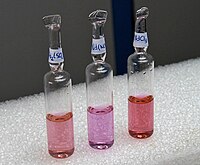User:Praseodymium-141/Neodymium/Compounds
Compounds[edit]
Some of the most important neodymium compounds include:
- halides: NdF3; NdCl2; NdCl3; NdBr3; NdI2; NdI3
- oxides: Nd2O3
- hydroxide: Nd(OH)3
- carbonate: Nd2(CO3)3
- sulfate: Nd2(SO4)3
- acetate: Nd(CH3COO)3
- neodymium magnets (Nd2Fe14B)
Some neodymium compounds have colors that vary based on the type of lighting.[1]
-
Neodymium compounds in fluorescent tube light—from left to right, the sulfate, nitrate, and chloride
-
Neodymium compounds in compact fluorescent lamp light
-
Neodymium compounds in normal daylight
Halides[edit]
Neodymium can form four trihalides of the form NdX3. They can be prepared by reacting neodymium with the corresponding halogen:[2]
- 2Nd (s) + 3F2 (g) → 2NdF3 (s) [a violet substance]
- 2Nd (s) + 3Cl2 (g) → 2NdCl3 (s) [a mauve substance]
- 2Nd (s) + 3Br2 (g) → 2NdBr3 (s) [a violet substance]
- 2Nd (s) + 3I2 (g) → 2NdI3 (s) [a green substance]
The dihalides NdCl2 and NdBr2 are dark green solids,[3] with the same crystal structure as PbCl2[3] and NdI2 is a dark purple solid. They can be obtained in the Nd-NdX3 eutectic system.[4]
Organoneodymium compounds[edit]
Organoneodymium compounds are compounds that have a neodymium–carbon bond. These compounds are similar to those of the other lanthanides, characterized by an inability to undergo π backbonding. They are thus mostly restricted to the mostly ionic cyclopentadienides (isostructural with those of lanthanum) and the σ-bonded simple alkyls and aryls, some of which may be polymeric.[5]
- ^ Burke M.W. (1996) Lighting II: Sources. In: Image Acquisition. Springer, Dordrecht. https://doi.org/10.1007/978-94-009-0069-1_2
- ^ Neodymium: reactions of elements Archived (Date missing) at webelements.com (Error: unknown archive URL). WebElements. [2017-4-10]
- ^ a b Georg Brauer (Hrsg.), unter Mitarbeit von Marianne Baudler u. a.: Handbuch der Präparativen Anorganischen Chemie. 3., umgearbeitete Auflage. Band I, Ferdinand Enke, Stuttgart 1975, ISBN 3-432-02328-6, S. 1081.
- ^ Leonard F. Druding, John D. Corbett (October 1959). "Rare Earth Metal-Metal Halide Systems. The Preparation of Neodymium(Ii) Halides". Journal of the American Chemical Society. 81 (20): 5512. doi:10.1021/ja01529a067. ISSN 0002-7863. Retrieved 2022-07-19.
- ^ Greenwood and Earnshaw, pp. 1248–9






